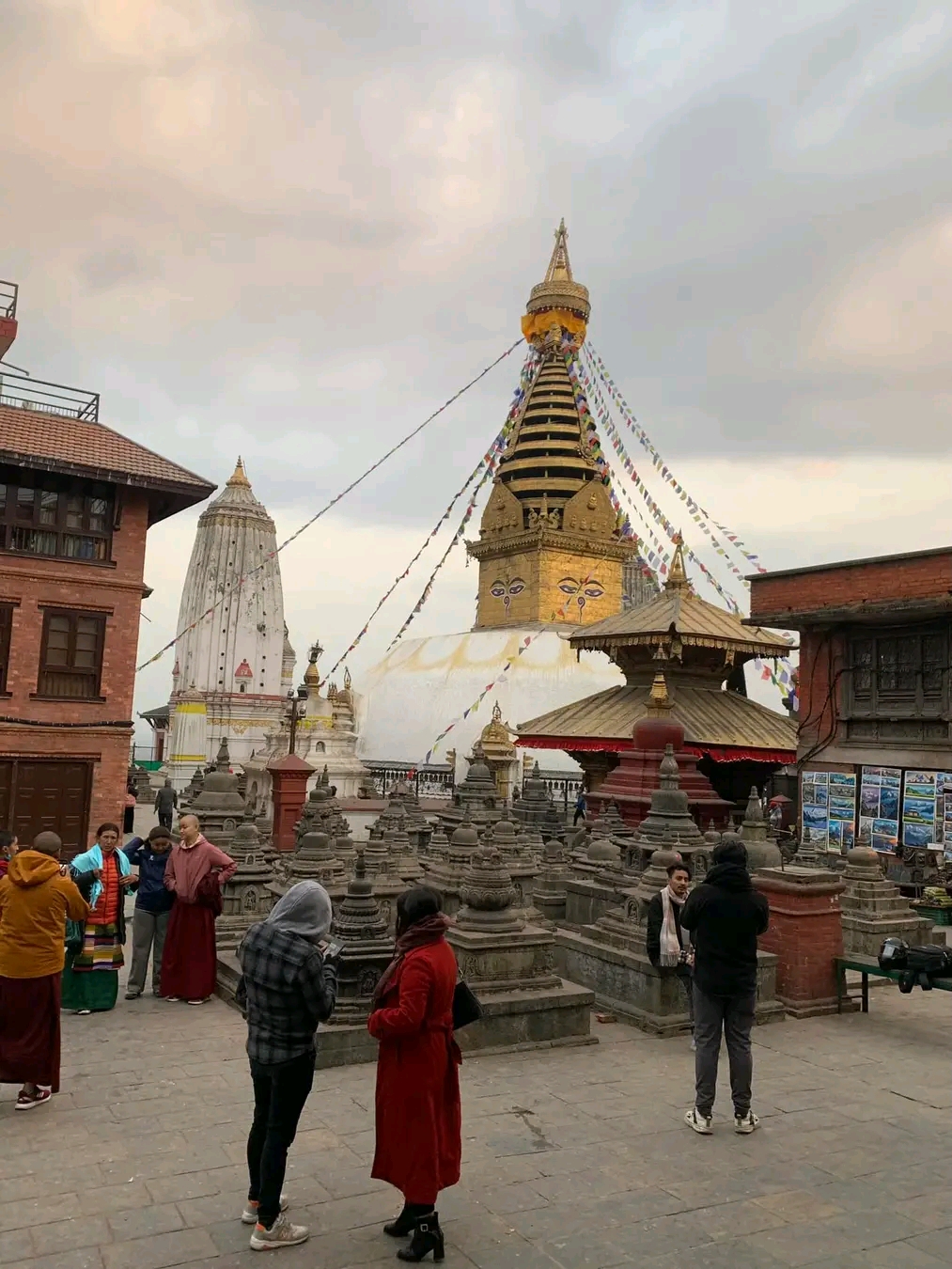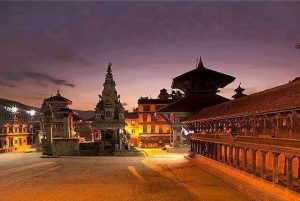Swayambhunath refers to Swayambhu Stupa. It is also known as a ‘unique shining beacon’ of religious and cultural wealth in Nepal. It is one of the oldest and most revered places of pilgrimage in Nepal, Swayambhunath Stupa being a central focus for many visitors. Known as the ‘Monkey Temple,’ this swayambhunath stupa sits atop a hill in northwestern Kathmandu. It has been a center of devotion for over 1500 years. The term ‘Swayambhu’ itself also suggests something biblical:’self-sprung’ or’self-manifested’. Swayambhunath stupa is an example of a harmonious mixture of Hinduism and Buddhism, which is typical for Nepal. That is why Swayambhunath is a place of awakening, peace, and blessings, encased in a strange time. Swayambhu, like other Kadampa temples, offers spiritual freedom and a sense of transcendence beyond time and space. The stunning views of Swayambhunath Stupa and the beauty of the Kathmandu Valley are truly remarkable.
Exploring the Ancient Origins of Swayambhunath Stupa in Nepal
Mythical Beginnings of the Swayambhunath Stupa: Legends and Lore
The Swayambhunath Stupa is more than a historical monument; it embodies a deep mythological significance, reflecting the spiritual heritage of Nepal. If there is Swayambhunath, it cannot just be a stupa; it has its roots in the myths of the Kathmandu Valley. In Swayambhu purana, a Buddhist scripture that this valley was once a quite large hollow known as Taodhanahrada, which was filled with waters. In the golden Age, the first in the list of seven Buddhas Vipaswi Buddha came to this lake along with his followers. Observing that there was no ‘a’ lotus flower, he sowed a lotus seed in the center of the water. After eons of years, there flowered a miraculous lotus and from it came forth the eternal, self-existent flame Jyotipura. The flame, which is encased in the stupa, represented the enlightenment and the ultimate truth that dwells within each being.
The legend further speaks of Manjushri, a bodhisattva of wisdom, who found the eternal fire at Swayambhunath while meditating on Panchasira Parvat. He, therefore, excavated a gorge at Chobar with his sword to facilitate more devotees accessing this holy place. He used the sword to cut the lake and fill the valley that we now call Kathmandu. Not only was the flame discovered through this great act, but it also resulted in the emergence of human populations in the valley, with Swayambhunath at the helm as the center of worship.
Historical Foundations of the Swayambhunath Stupa in Nepal
While the Swayambhunath stupa legend highlights its significance, historical documents indicate that King Vasudeva Manadeva constructed the stupa during the Licchavi period. Around the 5th century, King Vasudeva Manadeva, who reigned from 464 to 505 CE, is credited with commissioning the stupa. Inscription at the base of the stupa confirms that the terrace was expanded and decorated in 640 CE.
However, the site religion extends back in time from these subsisting erections. Some historians believe that around the 3rd century BCE, Ashoka the Great, a Mauryan emperor and convert to Buddhism, reached this site and built a temple on the hill. Although this early temple may have been lost due to later invasions, it highlights the long-standing significance of the hill as a place of worship.
Swayambhunath Temple: Harmonizing Hindu and Buddhist Beliefs
The Swayambhunath Stupa serves as a remarkable blend of both Hindu and Buddhist traditions in Nepal. Swayambhunath is a remarkable monument for it embodies traditions of both Buddhism and Hinduism. Different from many places of worship which may be constructed solely for one faith, Swayambhunath is one of the evidence in the country portraying the embedding of various religions. People from both Buddhist and Hindu religions visit the place to bow down and rotate prayer wheels to take blessings.
The confluence of traditions is clear, not only with respect to architecture and rituals but also to the fairs held here. For example, Buddha Jayanti, which commemorates the birthday of Buddha, is celebrated at Swayambhunath stupa with equal pomp. At the same time, the place is also very important for the Hindus as it serves as one of the major places of visit during the annual Chaitra Dashain, which pays homage to Goddess Durga’s victory over the demon Mahishasura.
Swayambhunath contains both Hindu and Buddhist influences and practices, although the two religions do not rub against each other in derogatory manner but enrich the temple even more with their syncretism. The place is a bouquet of compassion, tolerance, and devotion that are the commonalities of both religions.
Architectural Wonders of the Swayambhunath Stupa: Design and Symbolism.
Unveiling the Spiritual Essence of Swayambhunath Stupa
The Swayambhunath Stupa is more than a historical monument; it embodies a deep mythological significance, reflecting the spiritual heritage of Nepal.“ This would also complement the discussion of the stupa’s architecture and symbolism.In the middle of the Swayambhunath complex stands the grand structure of a stupa. The whiteball representing the earth rests at the base of the stupa in earth and also depicts the lotus of death. The cubic structure that crowns the dome contains the eyes of Buddha and is carved on each of the four vertical surfaces that denote the four angles and depicts the Buddhist’s abilities and also the pathway to awakening. The eyes are encircled with a mystifying third eye, which signifies the possessing of inner insight.
The above cube has beneath it the ‘golden spire,’ as it is referred to, which constitutes a tower consisting of thirteen segments representing the numerous levels of enlightenment every person must achieve before attaining Buddhahood. Each of these levels is a stage of comprehension following the last one where one overcomes the condition state, which is otherwise referred to as rebirth.
The Five Buddhas and Their Symbolism at Swayambhunath Stupa
Alongside the stupa are the images of the Panch Buddhas (Five Wise Ones), each representing one of the five elements of the universe: ether, water, earth, fire, and air. These five Buddhas—Vairochana, Akshobhya, Ratna Sambhava, Amitabha, and Amoghasiddhi—are highly significant in the Vajrayana tradition of Buddhism. Their presence at Swayambhunath highlights the temple’s connection to this Buddhist tradition. The statues of these Buddhas each have distinct mudras, which enhance the deeper spiritual meaning of the temple’s architecture, inviting visitors to explore both its external beauty and internal significance.
Journey Up the 365 Steps: Pilgrimage and Devotion at Swayambhunath stupa
Standing tall on the Swayambhunath hill is the most interesting feature of this stupa, which is a 365-step stairway that takes pilgrims from the foot of the hill to the top of the stupa. When climbing these steps, which are an act of worship, many pilgrims walk round the prayer wheels set about that footpath. The climbing shows the way to enlightenment as it is progressive towards cravings being reduced and hence leading closer to a pilgrim’s awakening.
In case one gets tired in the process of climbing up the stairs, there is a slightly cut way known as the southern part of the stupa, which can be accessed by car or cab. But if you feel up to it, the conventional way that begins at the bottom of the hill and weaves upwards through the vegetation is not only the quickest but lifts the spirit of travelers quite vigorously as they have time to think about their their spiritual life.
Festivals and Religious Significance of Swayambhunath Temple
Buddha Jayanti in Swayambhunath stupa
Buddha Jayanti, which commemora- Swayambhunath, also celebrates one of the most crucial festivals. It is the birthday, enlightenment and death of lord Buddha. People come to the site with flowers on the same date, and the themio stupa is surrounded by crowds of devotees offering prayers, lighting of lamps made of butter and contributing money. It is a festival that encourages everyone to reflect upon the values of compassion, non-violence and wisdom of Buddha.
Losar in Swayambhunath stupa:
Swayambhunath holds significant importance for other Buddhist followers, particularly Tibetans. The Tibetan New Year, known as Losar, is celebrated with a variety of activities at the stupa. People from different backgrounds, including monks and laypeople, gather to pray for peace, prosperity, and health in the coming year. The festival includes traditional Tibetan music, dance, and colorful processions, making it one of the most lively and vibrant celebrations at Swayambhunath.
Gunla: A Newari Buddhist Festival in Swayambhunath stupa
A considerable part of the cultural preservation of the Kathmandu Valley can be attributed to the Newari community, which also celebrates the month-long festival of Gunla at Swayambhunath. During Gunla, the followers are seen going for the pilgrimage to the stupa daily and playing music and praying for Buddha. There are also parades featuring traditional musical bands, as well as showcases of an old Buddhist scripture and images.
Culinary Delights Around Swayambhunath Stupa: Newari and Tibetan Cuisine
No pilgrimage or any visit is ever complete unless one enjoys what has to be offered by the cuisine around Swayambhunath. The food culture around the temple embraces the multi-ethnicity of Kathmandu, with a highlight of Newari and Tibetan cuisine in the temple vicinity.
Newari Cuisines in Swayambhunath Stupa
An aspect of the Newari community’s rich culture is the cuisine, and different meals can be found and eaten in the vicinity of Swayambhunath. One of the Newari dishes that visitors should not miss is the samay baji, a platter of rice with three kinds of meat and lentils with various pickles. Usually, the crispy rice comes with bara, which is lentil cakes, and chhoila, which is spiced, grilled and wrapped meat.
Tibetan Food around Swayambhunath Temple
Because of the strong Tibetan Buddhist influence at Swayambhunath, Tibetan cuisine is also easily accessible The most consumed item of Tibetan cuisine is Momo (dumplings), which are always filled with some mixture of minced meat, hydrocolloids or cheeses. Accompanied by a hot, spicy tomato dressing known as achar, momos are a popular snack for both the locals and tourists. Another typical Tibetan meal is thukpa, a soup with noodles and meat, vegetables, and spices, which is ideal for warming the body after climbing to the stupa.
Street Food and Cafes around Swayambhunath Stupa
Also for those who would just like to grab something to eat or dine rather casually, Swayambhunath also has a number of street food and small cafes. In these places burgers, local wrap sandwiches or fried delights including samosas, pani puri, and chatpate—a spicy puffed rice based snack with a tamarind sauce—are served. Travelers may even locate tea houses offering a chai or the famous butter tea from Tibet, a type of tea prepared with tea leaves, butter from a yak, and salt. Sipping on some butter tea while having a view of the Kathmandu Valley from the top of the hill is relaxing and fulfilling.
Preservation of Swayambhunath Stupa: Restoration Post-2015 Earthquake
Restoration and Preservation Efforts for Swayambhunath Stupa After the 2015 Earthquake
As time progresses, there has been re-storing and even renovations of the structures for Swayambhunath Temple so as to ensure that the importance and accessibility of the temple do not get diminished over time. The Swayambhunath Stupa was also affected by the earthquake that hit Nepal in 2015 and which left many scars throughout the country. The ‘uttachetra’ or spire and some smallerolla around the stupa also suffered indignity. Nonetheless, because of the rapid response of government, international agencies and local people, reconstruction started quickly and the stupa was fully restored.
The preservation of the falsely unique monument, the stupa with the surrounding monastery, and other monumental complexes continues with assistance from the Kathmandu Valley Preservation Trust and other like-minded heritage organizations. Caring for structural and cultural injuries and implementing eco-friendly modernization practices are some of the most successful strategies aimed at encouraging and managing the impact of the visitations on the area.
Complete Travel Guide for Visiting Swayambhunath Temple: Tips and Insights
Optimal Visiting Times for Swayambhunath Stupa: When to Go?
Swayambhunath can be visited throughout the year, but the peak times are when the weather is really favorable, especially in autumns and springs, and the skies are clear. These seasons also see celebratory events like Buddha Jayanti and Losar, where the observations from the visitors will also be interesting.
Getting to Swayambhunath Stupa: Directions and Transportation
Swayambhunath is located while moving about three kilometers from the center of Kathmandu. Getting there by taxi is straightforward. For those who prefer to walk, it takes about 30 to 45 minutes from Thamel. Visitors can enter the site from two main routes: the traditional 365-step stairway or the road leading to the back of the hill.
Swayambhunath: Entry Fees, Hours, and Visitor Information
Visitors from foreign countries are charged a small fee, which goes to the preservation and protection of the site. Making a visit to Swayambhunath stupa can be done between sunrise and sunset. This gives those willing a chance to have some early morning prayers or watch the sunset over the valley.
Enduring Legacy of Swayambhunath Stupa: A Symbol of Nepal’s Spiritual Heritage
Apart from being only a historical monument, Swayambhunath stupa serves as a living relic of the rich culture, religion, and harmony of Nepal. Swayambhunath stupa amazes and invokes respect from all people who visit it as much as it has impressive architecture, a peaceful environment, and lively celebrations.
Both the worshippers and the visitors find the Swayambhunath stupa rich in the spirituality of the Nepalese people’s lives. The energy of the stupa and the wide panoramic view of the valley makes us look back, and when we stop thinking for a while, it helps in making a pause wherein is enshrined a flash of memory. As the centuries have passed, Swayambhunath presumably continues to remain as it is a vaunted center of peace and enlightenment for generations to come.



